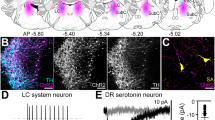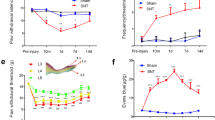Abstract
One of the most striking advances in the study of neurotransmission during the past decade has been the recognition that nerve terminals have receptor sites which, when activated, modulate transmitter release1–4. The most extensively studied have been the α-adrenoceptors of noradrenergic sympathetic terminals, activation of which inhibits transmitter release. It is widely believed that the prejunctional α-adrenoceptors are activated by transmitter noradrenaline, which results in inhibition of subsequent transmitter release1–6, thereby forming an inhibitory feedback system. However, this hypothesis has recently been challenged by Angus and Korner7 on the basis of observations made with short trains of stimulation applied to the intramural sympathetic nerves of isolated guinea pig atria. We have, therefore, re-examined the question using the same tissue and applying not only short, but also longer, trains of stimulation. We report here a time delay before the inhibitory feedback effect through prejunctional α-adrenoceptors is manifested; thus the effect will not be observed unless a sufficiently long train of stimulation is applied. Furthermore, there is no pulse-to-pulse inhibitory feedback regulation of transmitter release for trains of stimulation in which the pulse interval is extended to 8 s.
This is a preview of subscription content, access via your institution
Access options
Subscribe to this journal
Receive 51 print issues and online access
$199.00 per year
only $3.90 per issue
Buy this article
- Purchase on Springer Link
- Instant access to full article PDF
Prices may be subject to local taxes which are calculated during checkout
Similar content being viewed by others
References
Langer, S. Z. Br. J. Pharmac. 60, 481–497 (1977).
Starke, K. Rev. physiol. biochem. Pharmac. 77, 1–124 (1977).
Westfall, T. C. Physiol. Rev. 57, 659–728 (1977).
Rand, M. J., McCulloch, M. W. & Story, D. F. in Adrenergic Activators and Inhibitors: Handbook of Experimental Pharmacology 54/1 (ed. Szekeres, L.) 233–266 (Springer, Berlin, 1980).
Rand, M. J., Story, D. F., Allen, G. S., Glover, A. B. & McCulloch, M. W. in Frontiers in Catecholamine Research (eds Usdin, E. & Snyder, S. H.) 579–581 (Pergamon, New York, 1973).
Rand, M. J., McCulloch, M. W. & Story, D. F. in Central Actions of Drugs in Blood Pressure Regulation (eds Davies, D. S. & Reid, J. L.) 94–132 (Pitman, Tunbridge Wells, 1975).
Angus, J. A. & Korner, P. I. Nature 286, 288–291 (1980).
McCulloch, M. W., Rand, M. J. & Story, D. F. Clin. exp. Pharmac. Physiol. 1, 275–289 (1974).
McCulloch, M. W., Rand, M. J. & Story, D. F. Br. J. Pharmac. 46, 523–534P (1972).
Adler-Graschinsky, E. & Langer, S. Z. Br. J. Pharmac. 53, 43–50 (1975).
Langer, S. Z., Adler-Graschinsky, E. & Giorgi, O. Nature 265, 648–650 (1977).
Blinks, J. R. J. Pharmac. exp. Ther. 151, 221–235 (1966).
McCulloch, M. W., Medgett, I. C. & Rand, M. J. Br. J. Pharmac. 67, 535–543 (1979).
Author information
Authors and Affiliations
Rights and permissions
About this article
Cite this article
Story, D., McCulloch, M., Rand, M. et al. Conditions required for the inhibitory feedback loop in noradrenergic transmission. Nature 293, 62–65 (1981). https://doi.org/10.1038/293062a0
Received:
Accepted:
Issue Date:
DOI: https://doi.org/10.1038/293062a0
This article is cited by
-
Individual sympathetic varicosities possess different sensitivities to alpha 2 and P2 receptor agonists and antagonists in mouse vas deferens
British Journal of Pharmacology (1999)
-
One hundred years of adrenaline: the discovery of autoreceptors
Clinical Autonomic Research (1999)
-
ω‐Conotoxin GVIA‐resistant neurotransmitter release from postganglionic sympathetic nerves in the guinea‐pig vas deferens and its modulation by presynaptic receptors
British Journal of Pharmacology (1998)
-
Prominent sympathetic purinergic vasoconstriction in the rabbit splenic artery: potentiation by 2,2′‐pyridylisatogen tosylate
British Journal of Pharmacology (1997)
-
P2‐receptor modulation of noradrenergic neurotransmission in rat kidney
British Journal of Pharmacology (1997)
Comments
By submitting a comment you agree to abide by our Terms and Community Guidelines. If you find something abusive or that does not comply with our terms or guidelines please flag it as inappropriate.



